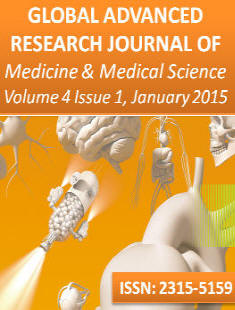|

January 2015 Vol. 4 Issue
1
Other viewing option
Abstract
•
Full
text
•Reprint
(PDF) (2,361 KB)
Search Pubmed for articles by:
Tamura NK
Svidzinski TIE
Other links:
PubMed Citation
Related articles in PubMed
|
|
Global Advanced Research Journal
of Medicine and Medical Sciences (GARJMMS) ISSN: 2315-5159
January 2015 Vol. 4(1), pp.
028-034
Copyright © 2015 Global Advanced
Research Journals
Full Length Research Paper
|
Adherence and biofilm formation of Fusarium
oxysporum isolated from a corneal ulcer
Nathalie Kira Tamura1,
Giuli Kira2, Eliana Valeria Patussi1,
Lucelia Donatti3 and Terezinha Inez
Estivalet Svidzinski1*
1Department
of Clinical Analysis, Division of Medical Mycology,
State University of Maringá, Paraná, Brazil.
2Hoftalon,
Londrina, Paraná, Brazil.
3Department
of Biology, Federal University of Paraná, Curitiba,
Brazil.
Corresponding Author
E-mail:
tiesvidzinski@uem.br,
terezinha@email.com;
Phone: +5544 3011-4809; Fax: +5544 3011-4860
Accepted 13 January, 2015
|
|
Abstract |
|
Fusarium oxysporum
is one of the principal agents of fungal keratitis,
causing morbidity and loss of vision moreover
contact lenses are important cofactor. This study
aimed to evaluate the capacity for adherence,
invasion, and biofilm formation in vitro of a sample
of Fusarium isolated from a human corneal
ulcer. The biofilm formation capacity of the fungal
isolate was evaluated by the XTT reduction
colorimetric method, on polystyrene Microplates at
intervals of 1, 2, 4, 8, 24, and 48 hours. The
viability of the adhered fungal cells was evaluated
by LIVE/DEAD staining in confocal scanning
fluorescence microscopy. Hydrophilic contact lenses
were inoculated with 106 colony-forming
units per milliliter of the fungus to evaluate
adherence, by counting of strongly adhered cells,
and the capacity for invasion observed by scanning
electron microscopy.
The formation of a biofilm by F. oxysporum
was demonstrated by an increase in the intensity of
XTT from 8 to 48 hours. LIVE/DEAD staining
and XTT showed that the adhered fungi remained
viable and metabolically active. F. oxysporum
showed a high adherence capacity within 1 hour of
incubation. After 72 hours the fungus had invaded
and completely penetrated the contact-lens matrix.
Concluding
F. oxysporum, isolated from a
fungal keratitis, showed a high capacity to adhere,
invade, and form a biofilm. In addition, fungal
cells remain viable and metabolically active after
adhering, suggesting a potential for infection.
Key-words:
Fungal keratitis, Fusarium biofilm, Contact
lenses, Virulence factors.
|
| |
|
